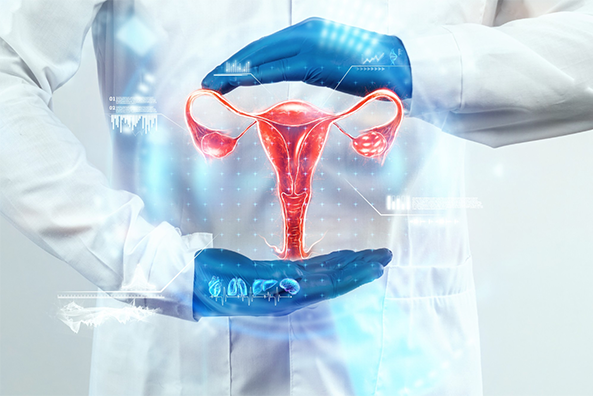Uterus Fibroids & Adenomyosis
Uterus Fibroids
Uterine fibroids (also referred to as leiomyomas or myomas) are the most common pelvic neoplasm in females. They are benign tumors arising from the smooth muscle cells and fibroblasts of the myometrium. Uterine fibroids usually arise in reproductive-age females (generally between 25-35 years old), and the prevalence rate will be 40-50% before and after menopause.
Symptoms
Most people with uterine fibroids do not show obvious symptoms, and they are typically found incidentally when having ultrasound examination. When symptomatic, typically present with symptoms of abnormal uterine bleeding (heavy or prolonged menstrual bleeding), pain (menstrual pain and dyspareunia), and compressive symptoms (lower back pain, urinary frequency, and constipation). Uterine fibroids may also have reproductive effects (eg, infertility, adverse pregnancy outcomes). Among infertile women, 3 out of 100 suffer from uterine fibroids.


Adenomyosis
Adenomyosis is a type of endometriosis, which is a disease in which endometrial tissue of the uterus appears in the normal myometrium (uterine muscle tissue) causing hypertrophy of the myometrium. When the endometrial tissue is affected by hormonal changes during menstruation, these misplaced endometrial tissue is squeezed in the myometrium, although it will bleed and swell, it cannot peel off along the vagina, causing extreme swelling, pain and discomfort during menstruation. The surrounding uterine muscle tissue forms fibrotic lesion tissue due to long-term continuous stimulation, which gradually replaces the original normal uterine muscle tissue, forming the so-called “adenomyosis” or “endogenous endometriosis” disease. About 20% to 35% of women suffer from adenomyosis. The causes of adenomyosis may be related to factors such as heredity, hyperestrogenemia, endometrial injury (cesarean section, curettage), and viral infection, but the etiology is still unclear.
Symptoms
Patients with symptomatic adenomyosis present with uterine enlargement, abnormal uterine bleeding(heavy or prolonged menstrual bleeding), and gradually aggravated progressive dysmenorrhea. The most serious is infertility, and adenomyosis accounts for 20% to 50% of infertile women.
Frequently asked questions about HIFU
Is MRgHIFU effective in treating adenomyosis?
Adenomyosis can also be treated, whether it is suitable for treatment please consult your doctor for further evaluation.
Do I have to be hospitalized?
At present, MRgHIFU procedure can be treated as outpatient treatment (i.e. without hospitalization) in some countries, but hospitalization still required in Taiwan. You will need to be hospitalized the day before the treatment and the day after treatment total of 3 days. Hospitalization is to better ensure the outcome and safety of treatment, and for patients, medical insurance is usually covered and reimbursed.
Can I treat ovarian tumors or chocolate cysts?
At present, MRgHIFU is for benign tumors within the uterus, cannot apply to ovarian tumors and chocolate cysts.
Will the skin get burned by the high temperature HIFU treatment?
The part where the temperature rises is only in the fibroid position, don’t worry.
Will it recur after treatment?
After fibroids treatment, the chance of recurrence in the original position is about 2~5%, and there is also a chance of new fibroids in other locations. Relapse and new fibroids are mainly related to personal constitution. Unless the entire uterus is removed, any treatment has the same chance of recurrence and new fibroids.
Are there any discomfort after treatment?
Patients often ask how they feel after treatment, although MRgHIFU is a new technology of treatment without any wounds, but no matter what kind of treatment, there will be more or less discomfort after treatment. Feeling of discomfort (slight dullness) in the lower abdomen Increased vaginal discharge Pain in the muscles of the waist, abdomen and thighs After the treatment, the abdominal circumference (A.C.) of fewer patients became larger because of treatment area edema . There is a feeling of tightness in the skin of the lower abdomen Numbness, slight fever and even temporary weakness in the lower limbs Generally, symptoms will ease in one to two weeks, depends on the individual.
Is this procedure suitable for women who had a caesarean section?
If you had a caesarean section, you can also use MRgHIFU. However, due to individual basis, please consult your doctor.
After treatment, what is the recovery time before I can be back to normal daily activity?
It is recommended that at least you rest for a week before starting to lift heavy objects and exercise. Non-strenuous activities of daily life can be fully performed the next day after treatment.
For people with severe menstrual pain, will the pain ease immediately after surgery? Or will it take a while to eliminate the pain? Because fibroids and myoadenomas are not eliminated immediately.
Menstruation-related symptoms (dysmenorrhea, heavy menstrual bleeding, prolonged menstruation, etc.) will improve significantly in the first three months after treatment, by the first menstrual period after treatment, most patients should be able to see the improvement. HIFU is widely used in treating uterine fibroids in since 2010, no special latent problems have been found so far, we continue to pay attention to issues related to treatment safety.
After treatment, can I go back to my daily job?
Generally speaking, you can go back to work the day after treatment if there is no discomfort. However, try not to carry heavy objects and physically demanding work during the first week.
Is there any size limit for the treatment of uterine fibroids by MRgHIFU?
There is no special limit in size, but the range of treatment needs to be further evaluated by a physician/doctor after examination. Generally, if the fibroid partially locates beyond the pelvic cavity, the part of the fibroid within the pelvic cavity will be treated first, and then the need for re-treatment will be evaluated after a few months. If the symptoms have improved significantly, most of them do not need to be retreated. The details of the condition still need to be examined and explained by your doctor.
Can uterine fibroids shrink to the point of being completely invisible after treatment?
The size of fibroids will shrink by 50% in average within half a year and 85% in one year. Some people will shrink to complete disappearance, and some people cannot. But the part of fibroid tissue that has not disappeared has also been destroyed and inactive, but it is not easy to be absorbed by the body.
Do I have to do an MRI? Would I need to be hospitalized the day before treatment?
MRI is a necessary examination before MRgHIFU treatment, which needs to confirm the location, size and position of the affected area and normal tissues through MRI, and also rule out the possibility of malignant tumors through MRI. The day before hospitalization is a preparation for treatment.
Can I have sexual intercourse after treatment?
In general, we would suggest that after the first menstruation cycle then you can have sex life after treatment.
If I want to have MRgHIFU treatment, when can I get MRgHIFU treatment at the earliest after outpatient consultation?
Generally speaking, it takes about 2-4 weeks. Some pre-examination need to be arranged.
After MRgHIFU treatment, the endometrium is damaged to some extent, does that also affect embryo implantation? Can I still consider MRgHIFU treatment if I still want to prepare for pregnancy?
For patients who prepared for pregnancy, the doctor will evaluate whether MRgHIFU treatment is suitable based on the location, size, and position of your lesion relative to other healthy tissues. It will vary depending on individual’s situation.
Does this require anesthesia? Is it local anesthesia or general anesthesia?
No anesthesia is required for the treatment of uterine fibroids and adenomyosis, only conscious sedation and painkillers are used; you will stay conscious throughout the treatment.
After MRgHIFU treatment, when can I prepare for pregnancy?
Generally, it is recommended that you can prepare for pregnancy 3-6 months after treatment, but it should be evaluated by your doctor according to your condition.
